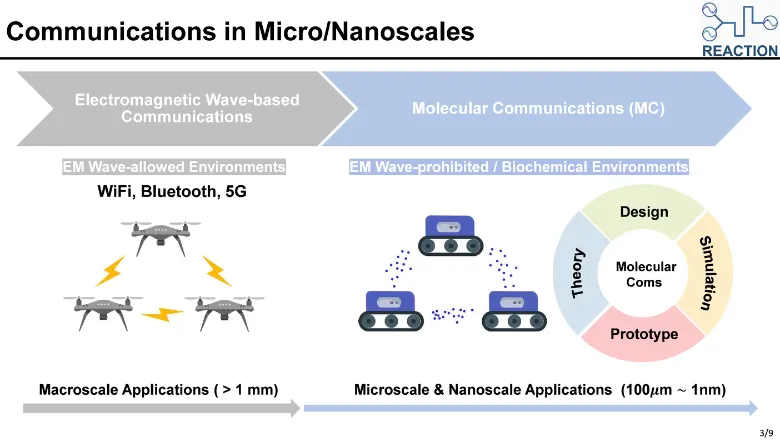Professor Yansha Deng's winning bid, REACTION, will help build a pathway to robot-to-robot communication and personalised healthcare for environments without electromagnetic waves.

The Department of Engineering's Professor Yansha Deng has been awarded a £1.3 million Starting Grant from the European Research Council to create devices that can compute and communicate without using electrical signals.
Building on her previously developed MIMIC platform, Professor Deng will create a number of new prototype molecular communication (MC) systems to be used across industry, search and rescue, augmented reality and personalised healthcare - including the automatic release of insulin in diabetic patients.
MC is the process of using chemical molecules to exchange information, where systems rely on molecules to carry data between a transmitter and a receiver. This is different from common wireless communication systems, like mobile phones and internet-connected devices, which rely on electromagnetic waves like microwaves to convey information.

Mirroring nature where MC is used to communicate between entities at a small scale, like cells, can overcome situations where traditional wireless communication systems could be unsafe. The electrical components in electromagnetic systems can cause inflammation in living tissue, and the presence of strong electromagnetic fields can interfere with heartbeat regulation and pose a danger in environments with volatile gas.
Whether you want to personalise drug delivery to ensure that diabetic patients are getting the right amount of insulin as soon as their blood sugar runs low or want to create an 'Internet of Smells' for transition between digital bits and olfactory experience - molecular communication can help do that."
Professor Yansha Deng
While previous MC methods have encoded instructions onto molecules through binary code using electrical components, Yansha and her team have previously developed a system that replaces these potentially damaging electronic components with components using small controlled chemical reactions in a microfluidic setup - a small microchip that manipulates fluids.
By integrating and building on the components of the previous MIMIC platform, the team aim to create several prototypes that would change the reactions encoding information. These would move the state of the reactants from a fluid to a gas, in the way of animal pheromones, allowing for robots to communicate with each other over distance without the need for electricity which could trigger dangerous scenarios.
By building more complex components, they also hope to translate digital bits into senses like smell and build smart drug delivery devices that can automatically release medicines when diseases are detected, or specific conditions are met.
With more complex components that can work across mediums, sense chemicals in the atmosphere and then perform their potentially lifesaving task without the need for electricity, our system can be used across different domains to empower scientists to improve vital fields like healthcare and search and rescue."
Professor Yansha Deng
Professor Deng said, "MC opens up a whole new pathway to what we think communication systems can achieve. Whether you want to personalise drug delivery to ensure that diabetic patients are getting the right amount of insulin as soon as their blood sugar runs low or want to create an 'Internet of Smells' for transition between digital bits and olfactory experience - molecular communication can help do that.
"With more complex components that can work across mediums, sense chemicals in the atmosphere and then perform their potentially lifesaving task without the need for electricity, our system can be used across different domains to empower scientists to improve vital fields like healthcare and search and rescue."
In the future, the team hope to use the baseline they create here to develop systems for a much broader set of use cases, each with their own chemical reactions and signalling components.






